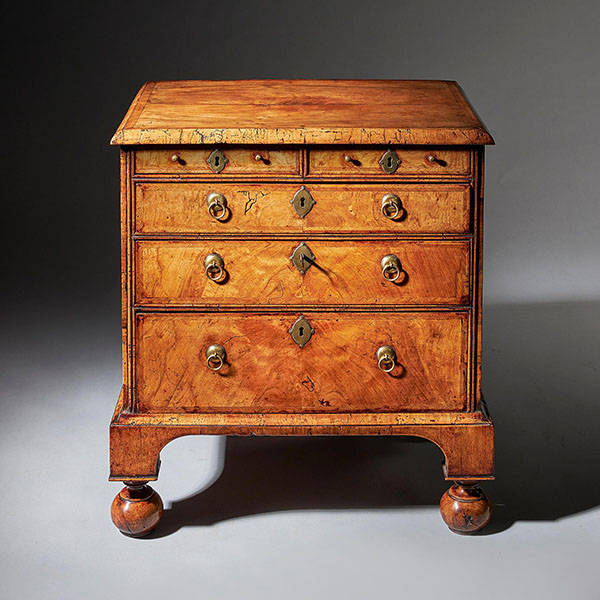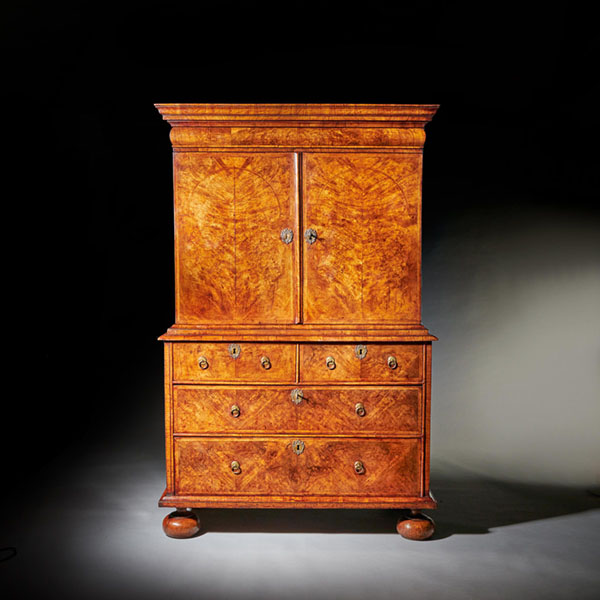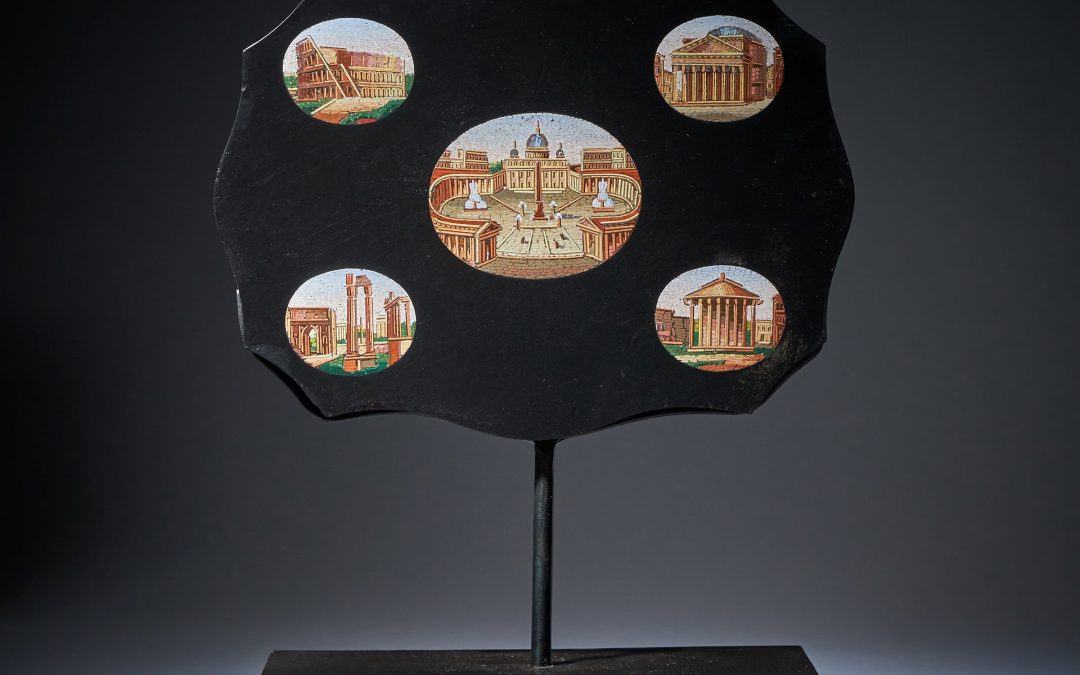Fine Brass Pocket Sundial and Compass by Michael Butterfield Paris
Sold
Request Information
Follow Us
Fine Brass Pocket Sundial and Compass by Michael Butterfield Paris
A fine brass Anglo-French octagonal pocket sundial with compass by Michael Butterfield, circa 1700.
The sundial can be used anywhere between latitudes of 40° and 60° covering Southern Spain and Italy north to Scandinavia. The elaborately engraved base plate has various Roman chapter rings with subdivisions on which the folding hinged gnomon (a triangular flap) casts its shadow. It is signed by the maker in the following manner: Butterfield A Paris. On one side is a glazed recessed compass, with a blued steel hand, to position the instrument in such a way that the time can be read. The triangular gnomon is richly engraved and can be set for a particular latitude by sliding the gnomon up or down, the latitude being indicated by the beak of a figured engraved bird. The folding gnomon and cut corners enable the dial to be carried in the pocket.
The underside shows the latitudes of various European places, including London and Rome.
Its maker Michael Butterfield (b.1635, d.1724) was an English instrument maker who based himself in Paris for a time. These types of dials, often replicated by other makers, became known as Butterfield Dials. They were a fashionable and functional traveller’s accessory from the late 17th century onwards.
Interestingly, early watches did not keep time particularly well and a dial such as this were used to regularly set a watch. Anecdotally, sundials may also have been preferred to sounding timepieces whilst on the road – the chimes being thought to attract thieves.
Similar examples can be found in the British Maritime Museum, V&A and the British Museum.
Condition
Good. Wear consistent with age and use.
Dimensions
Height: 2.56 in. (6.5 cm)
Width: 2.29 in. (5.8 cm)
Depth: 0.32 in. (8 mm)
Literature
Tardy, Dictionnaire des horlogers français, Paris, 1971, p. 103
C. Cowham, A Dial in Your Poke, Cambridge, 2004, passim
H.Higton, Sundials, An Illustrated History of Portable Dials, London, 2001, passim
PREVIOUSLY SOLD
No Results Found
The page you requested could not be found. Try refining your search, or use the navigation above to locate the post.
No Results Found
The page you requested could not be found. Try refining your search, or use the navigation above to locate the post.
YOU MAY ALSO LIKE

An extremely rare George I walnut chest of small proportions on ball and bracket
An extremely rare George I walnut chest of small proportions on ball and bracket £18,800[wpforms_selector form_id="11387" show_title="on" _builder_version="4.22.1" _module_preset="default" custom_margin="-30px||||false|false"...

A Rare 18th Century George II Musical Table Clock by Matthew King, c. 1735.
A Rare 18th Century George II Musical Table Clock by Matthew King, c. 1735. £24,500[wpforms_selector form_id="11387" show_title="on" _builder_version="4.22.1" _module_preset="default" custom_margin="-30px||||false|false"...

Signed Mid 19th C. Edo/Meiji Period Diminutive Lacquer Stacking Cabinet, Japan
Signed Mid 19th C. Edo/Meiji Period Diminutive Lacquer Stacking Cabinet, Japan £5,800[wpforms_selector form_id="11387" show_title="on" _builder_version="4.22.1" _module_preset="default" custom_margin="-30px||||false|false"...

A Fine 17th Century William and Mary Burl Walnut Cabinet on Chest, Circa 1690
A Fine 17th Century William and Mary Burl Walnut Cabinet on Chest, Circa 1690 £27,800[wpforms_selector form_id="11387" show_title="on" _builder_version="4.22.1" _module_preset="default" custom_margin="-30px||||false|false"...

Miniature William and Mary 17th Century Diminutive Olive Oyster Chest C.1690
Miniature William and Mary 17th Century Diminutive Olive Oyster Chest, C.1690 £15,900Follow UsMiniature William and Mary 17th Century Diminutive Olive Oyster Chest, C.1690 A Fine Miniature William and Mary 17th Century Diminutive Olive Oyster...

19th Century Grand Tour Micro Mosaic Tablet Depicting Italian Architecture
19th Century Grand Tour Micro Mosaic Tablet Depicting Italian Architecture £3,650Follow Us19th Century Grand Tour Micro Mosaic Tablet Depicting Italian Architecture A fine mid-19th century serpentine grand tour micro mosaic tablet or...

An extremely rare George I walnut chest of small proportions on ball and bracket
An extremely rare George I walnut chest of small proportions on ball and bracket £18,800[wpforms_selector form_id="11387" show_title="on" _builder_version="4.22.1" _module_preset="default" custom_margin="-30px||||false|false"...

A Rare 18th Century George II Musical Table Clock by Matthew King, c. 1735.
A Rare 18th Century George II Musical Table Clock by Matthew King, c. 1735. £24,500[wpforms_selector form_id="11387" show_title="on" _builder_version="4.22.1" _module_preset="default" custom_margin="-30px||||false|false"...

Signed Mid 19th C. Edo/Meiji Period Diminutive Lacquer Stacking Cabinet, Japan
Signed Mid 19th C. Edo/Meiji Period Diminutive Lacquer Stacking Cabinet, Japan £5,800[wpforms_selector form_id="11387" show_title="on" _builder_version="4.22.1" _module_preset="default" custom_margin="-30px||||false|false"...

A Fine 17th Century William and Mary Burl Walnut Cabinet on Chest, Circa 1690
A Fine 17th Century William and Mary Burl Walnut Cabinet on Chest, Circa 1690 £27,800[wpforms_selector form_id="11387" show_title="on" _builder_version="4.22.1" _module_preset="default" custom_margin="-30px||||false|false"...

Miniature William and Mary 17th Century Diminutive Olive Oyster Chest C.1690
Miniature William and Mary 17th Century Diminutive Olive Oyster Chest, C.1690 £15,900Follow UsMiniature William and Mary 17th Century Diminutive Olive Oyster Chest, C.1690 A Fine Miniature William and Mary 17th Century Diminutive Olive Oyster...

19th Century Grand Tour Micro Mosaic Tablet Depicting Italian Architecture
19th Century Grand Tour Micro Mosaic Tablet Depicting Italian Architecture £3,650Follow Us19th Century Grand Tour Micro Mosaic Tablet Depicting Italian Architecture A fine mid-19th century serpentine grand tour micro mosaic tablet or...












